Without fail every time I post an old photo of Penn Street there are multiple comments asking, “what happened to Reading?” (and this is putting it nicely). Generally these comments are rhetorical and negative in nature, but sometimes I believe folks are genuine in wanting to know how we went from thriving industrial city of 111,000 citizens in 1930 to the poorest city in the country with a population of 90,000 and poverty rate of 41.3% in 2011. So if you are reading this; you likely posed the question. The actual answer is multifaceted and complicated, but if you want insight based on what I have learned in my extensive amounts of historical research – keep reading.
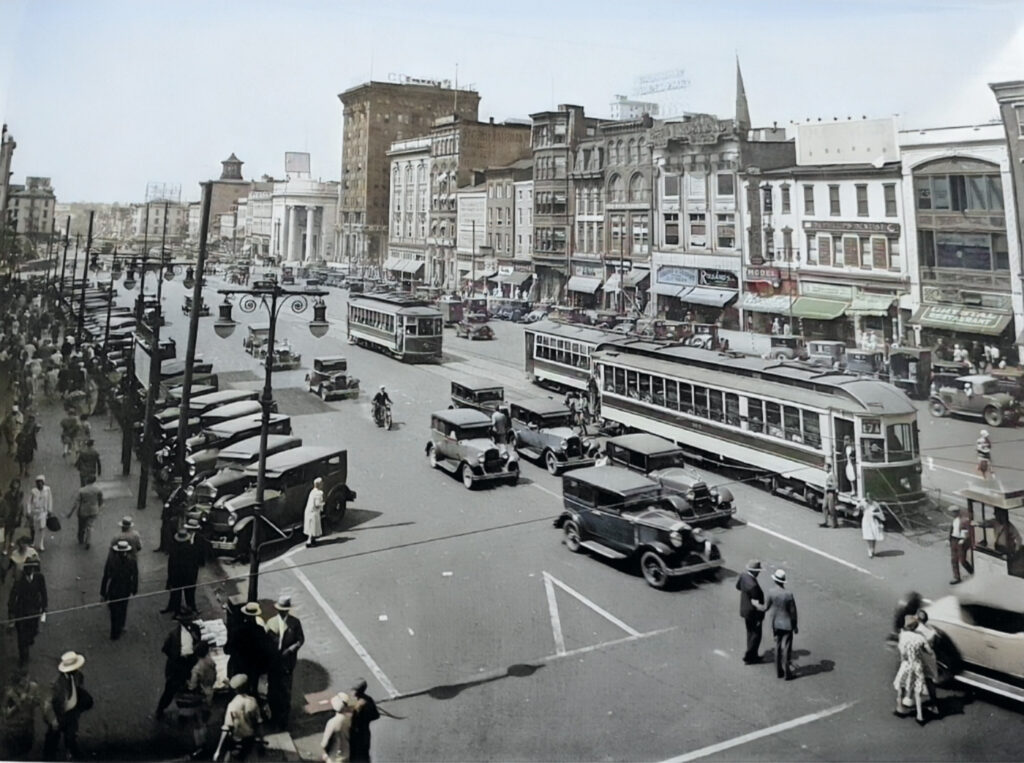
The photo above depicts Penn Street as it existed around 1930. The population of Reading was peaking at just over 110k people. Jobs were plentiful; if you quit one job in the morning you could find another in the afternoon. Yet to understand how we got the this point, we need to go back even further.
The Gilded Age – Industry Booms
The Philadelphia and Reading Railroad was Reading’s ticket to growth. While the company was chartered in 1833, the construction of railroad infrastructure really took off after the end of the Civil War. Railroads were essentially the veins of the American economy, and because one of the largest and most successful was based here, it is no surprise that other industries wanted to be here as well. In 1870 Reading’s population was only 34,000. In the following half-century that number tripled, the vast majority being European immigrants looking to make a go of the “American Dream“. Below is a comparison taken from the southeast corner of 6th & Penn looking west in 1870 and 1923. During that time period nearly every building on either side of the 400 and 500 blocks that encompass Penn Square were demolished and built new. So next time someone complains that today’s Penn Square is “not their Penn Street“, feel free to remind them that their Penn Street wasn’t their great-grandparent’s Penn Street either.
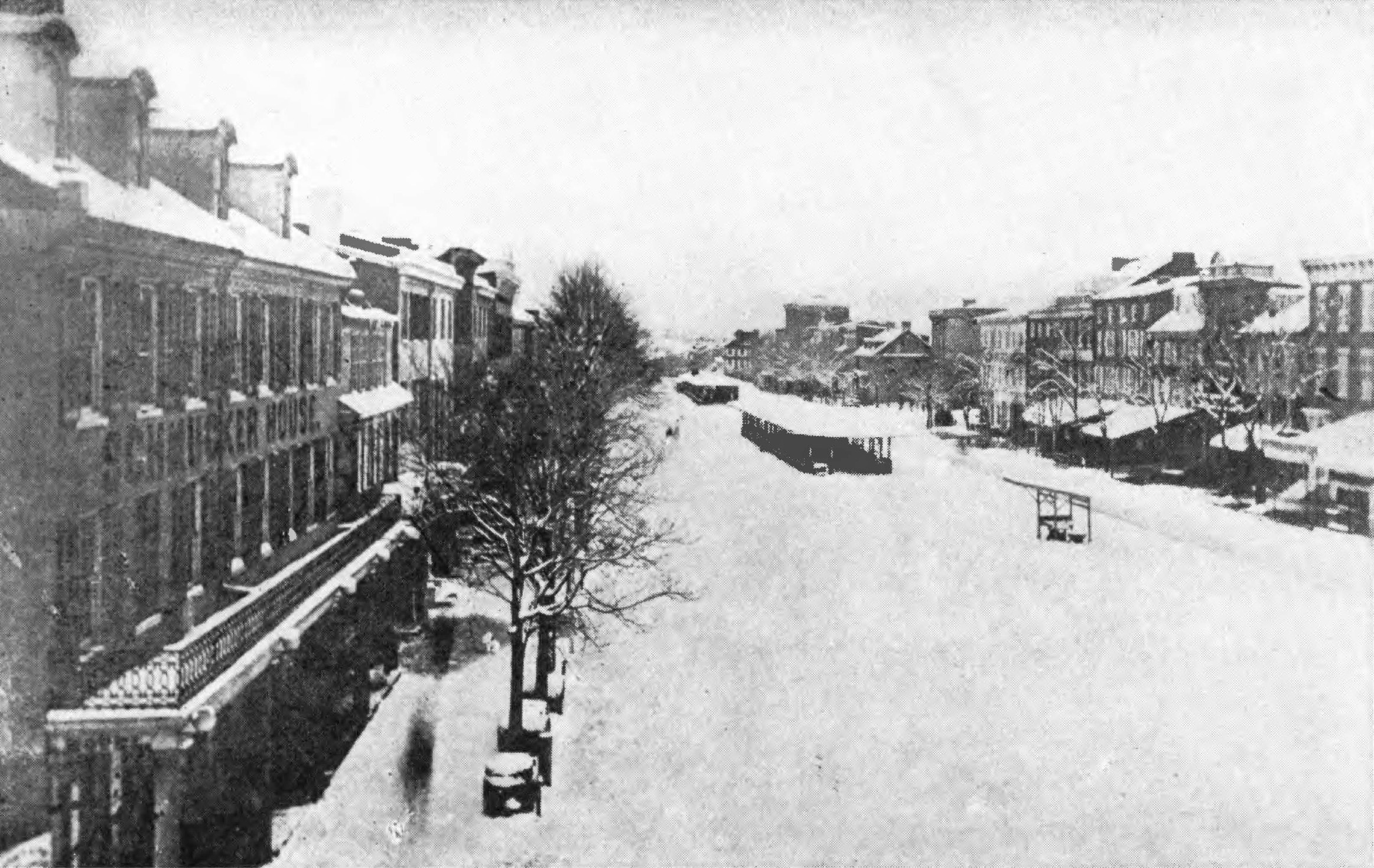

Growth of Penn Square between 1870 & 1920s – from market square to industrial hub
Reading economically peaked between 1900-1930ish. As proof of this, I have found that much of the infrastructure we still use today was implemented during this time period. The Lindbergh Viaduct, Penn Street Bridge, and Bingaman Street Bridge were all built during this timeframe. The Comfort Stations at 5th and Penn were constructed in 1921. Much of Reading’s most significant architecture was constructed during this timeframe as well; The Colonial Trust Company building in 1900, Pomeroy’s expansion in 1922, the Metropolitan Edison building in 1927, Abraham Lincoln Hotel in 1930. Perhaps the most impressive structure in Reading is still its Courthouse, completed in 1932. The latter two are outliers because while they were built in the wake of the Great Depression, planning for them had begun years before.
While economic growth during this time period was unprecedented, unregulated capitalism did not come without its challenges. As the name given to this era by historians suggests, what gave the outer appearance of abundance often came at the expense of the laborers. Working conditions were dangerous and there was little to no government oversight into worker exploitation. The richest 4,000 families in America around 1900 had amassed as much wealth as the other 11.6 million families combined. So while there was plenty of opportunity to find work, wages were low, income disparity was at an all time high and there wasn’t much ability to improve your class status. Keep in mind that men, women and children all worked to help support their struggling families. While there had been a few economic recessions during the Gilded Age and into the Progressive Era, the struggle felt by the working class came to a head with the Great Depression in 1929.
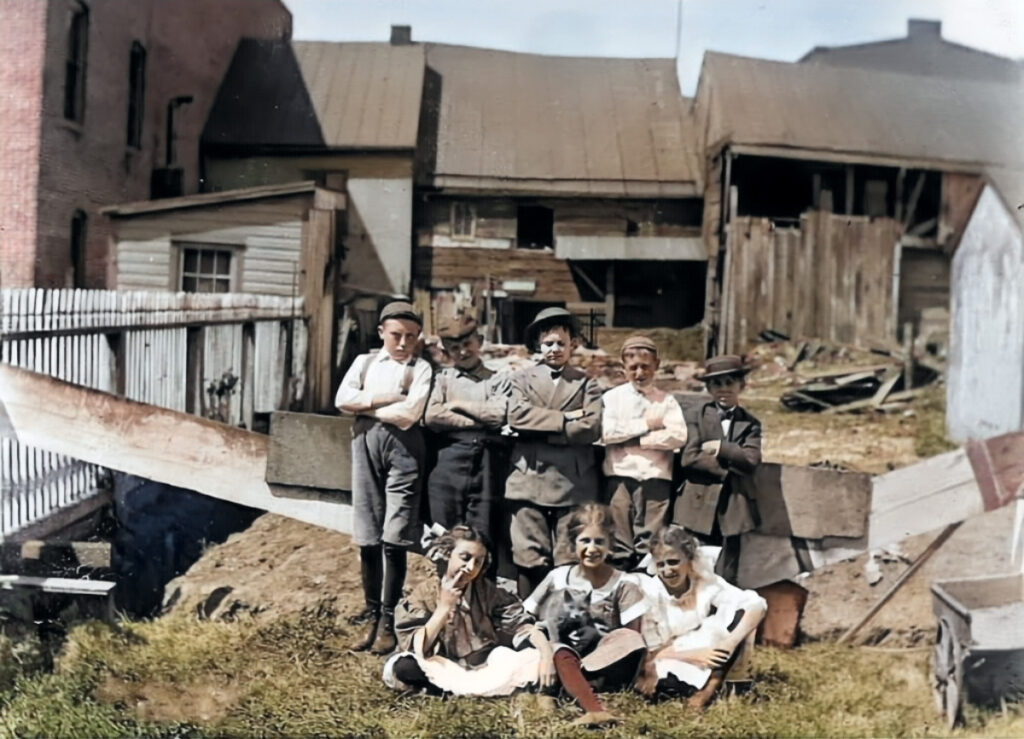
The Beginning of Social Policy
No doubt a turning point in American economics, the Great Depression put an end to unregulated capitalism and began an era of federal oversight, social policy and worker’s rights. In stark contrast to the Gilded Age and Progressive Era, the power swung wildly into the hands of the common people. The 1930s saw an influx of labor unions and strikes on our local industries as a result. Wyomissing’s Berkshire Knitting Mill, the largest hosiery manufacturer in the country at that time and employer to 5800 workers fought off union influence for nearly a decade.
As laws were passed preventing children from being exploited through working at young ages, Boroughs and Townships in the more rural areas surrounding Reading began implementing their own public education systems.
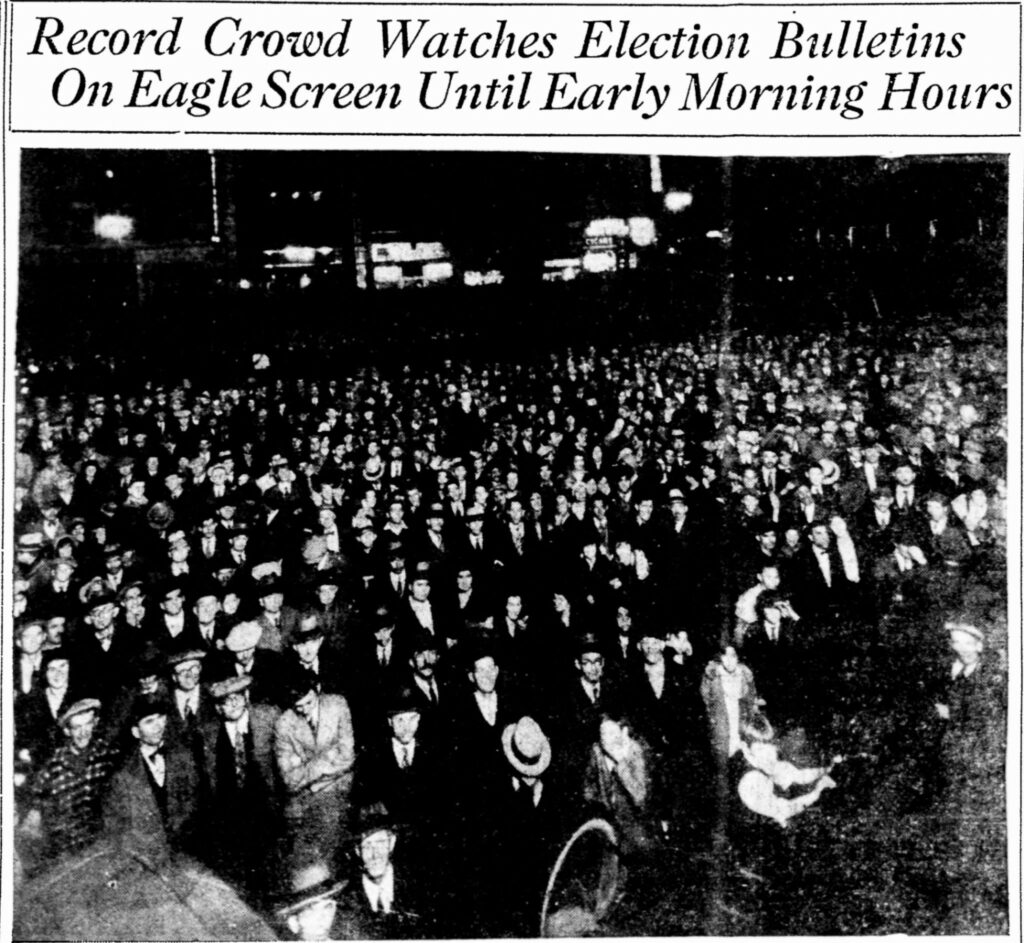
The Socialist Party rose to unprecedented levels of power locally, first with J. Henry Stump winning Reading’s Mayorship in 1927. They were so much of a threat that in the 1931 election Republicans and Democrats actually formed a coalition to defeat Stump by nominating one candidate between both parties. They called themselves “Fushionists“. It worked, ultimately; Democrat Herber Ermentrout would win that election for the Fushionists. He narrowly defeated Stump by 3000 votes, even though he should have had a vast majority being backed by two parties.
The Socialist Party came roaring back in 1935; J. Henry Stump would win the Mayorship again, making him the first Mayor in over a half-century to get a second term. Amos Lesher won a first-time Socialist Party Berks County Commissioner seat. The Socialists also won three council seats, a city treasurer and a city controller position that year. A record 41,525 Reading citizens showed up to the polls in 1935, and half of them voted for Stump.
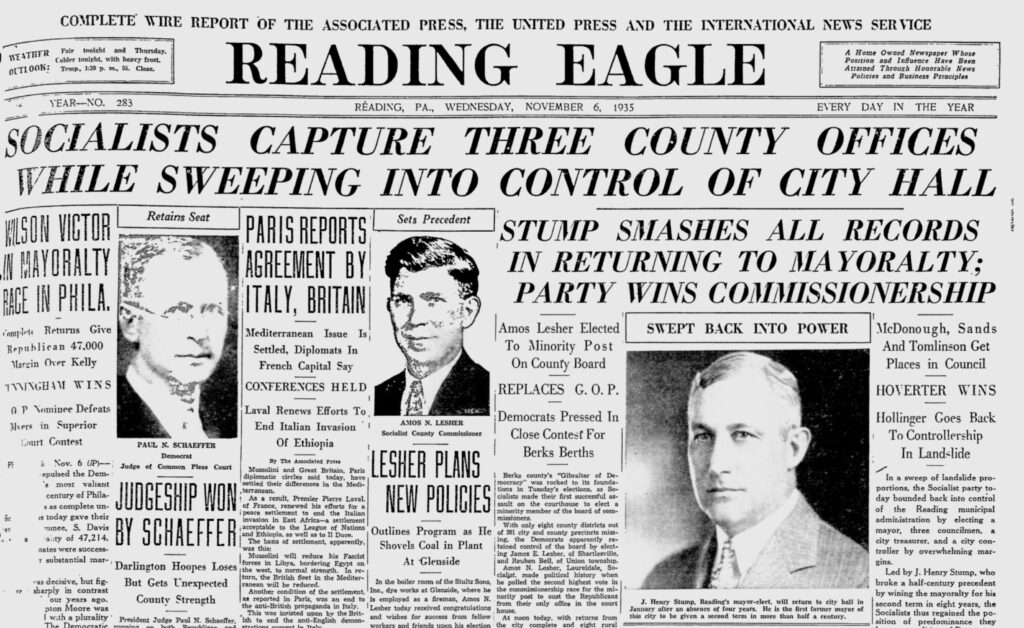
The 1930s through WWII is when Reading socially peaked. Many of the things we take for granted today were implemented during this time period. The 40 hour work-week became law in 1940, giving men more time off to spend with their families. Improved wages meant that families could live on one salary and women and children no longer needed to work. Children spent their new free time being further educated, getting involved in sports and other public school activities. All of this improved living for the majority manifested at the expense of the highest earners paying a higher share of taxes.
The rise of the Socialist Party was not confined to city limits, as 1935 also saw Cumru Township elect three new socialists to the school board, making their majority 6 to 1 over the lone Republican school board member. For context remember that the concept of public education as we know it today was only beginning to take shape. While “Socialism” has become a taboo subject in more modern society – public education is a socialist concept. Many of the programs we benefit from like public education, social security, the maintenance of public roads, and emergency services are because of this movement toward the betterment of society as a whole. The caveat is that it took money to create these betterment programs, and much of it came at the expense of the big industries in the form of tax increases. While the tax rate on top earners was at 24% in 1929 when the depression hit, rates in the 30s increased to 63% and continued to steadily increase, reaching 94% in 1944 – and continued above 90% until the 1970s.
The federal government was implementing similar social policy using these tax dollars; investing in its own infrastructure which included WPA projects like the William Penn Memorial Fire Tower, Skyline Drive road improvements, and Reading’s new post office at 5th and Court.
Working conditions improved with federal oversight, wages rose and then again crisis hit; World War II. The real decline of Reading started when our troops began returning home. The vast majority of those of you who are reading this entered the picture sometime after this point.
Mob Influence
My favorite comments are those that claim, “this would never happen when the mob controlled Reading, everything was so SAFE back then!“. As if organized crime is the type we should strive for. While the origins of mob influence in Reading can be traced to the 1920s with prohibition, mob control really peaked in the 1950s into the early 60s. Gambling machines were rampant and government officials got kickbacks to ensure the mobsters could commit their crimes without local police interference. If you owned a business which didn’t fold to mob demands, your business was ran out of town. This culminated in former Reading Mayor John Kubacki along with kingpins Abe Minker and Benny Bonanno being convicted of extortion in 1965. The U.S. Justice Department described what the Philadelphia Bruno crime family did to the city of Reading as “An outright rape of an American city.” I am not going to go on much about this era, as it is already well documented. Hopefully we can all agree that it isn’t an era to emulate and it certainly didn’t do Reading any favors under the guise of “safety”. If anything it set a precedent of corruption and caused a loss of industry from which the city still suffers.
Suburban Development
Development in the suburbs began in the 1920s, with ads for building new homes in communities like Lincoln Park and Stony Creek began popping up in the Reading Eagle. Moving to these areas further from the center of commerce in the city was more realistic by the 20s due to the increasing availability of the automobile. However it wasn’t until servicemen came back from World War II that development really took off. Due to the GI bill making home ownership easily affordable for returning veterans, working class families left urban areas en masse to build new homes in the suburbs. White picket fence, a single family home, and a yard for the kids became the new manifestation of the “American Dream“. In 1950 the city population still held at 109k, but for the next three decades fell 10k each decade until bottoming out in 1980 at 78k.
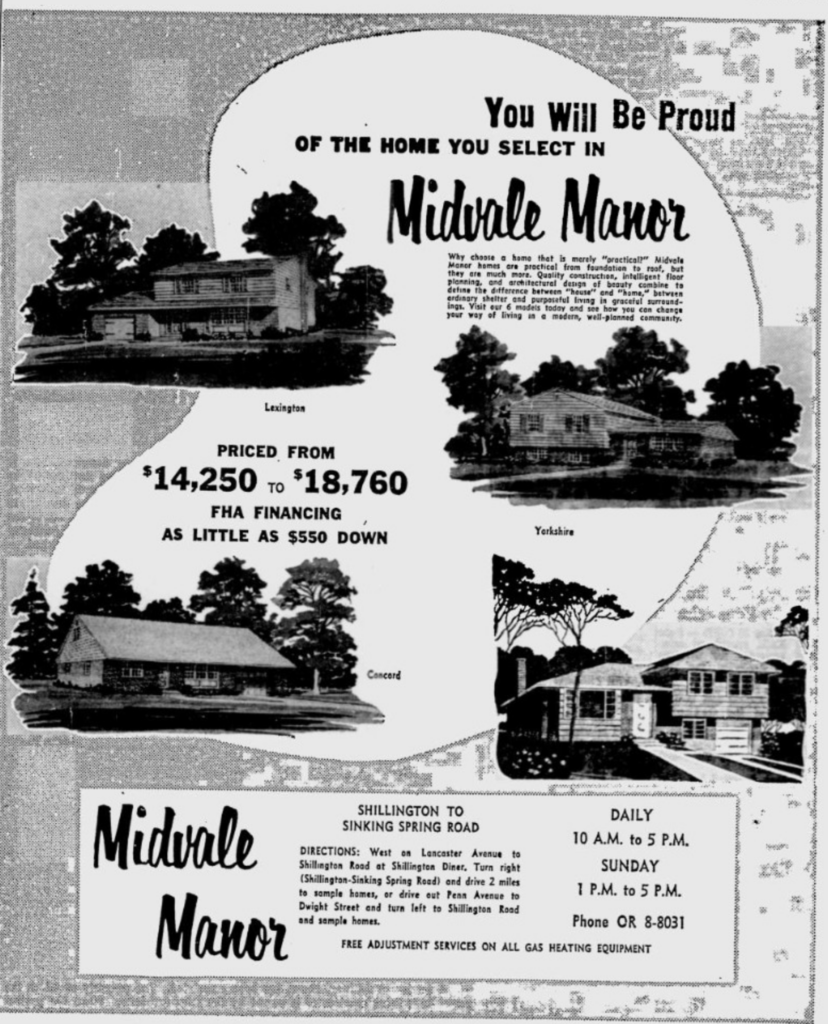
During those decades, driving down any city street you could see multiple homes for sale on the block. This exodus of white working-class people gutted Reading, plummeting the value of home prices and creating an atmosphere where poverty and crime flourished. The exodus of the working class could possibly have been overcome with a new wave of immigrants to take over the labor jobs, but my next two points will illustrate why that did not occur. While people never seem to have a problem pointing out that poverty and crime are Reading’s largest issues, very few ever want to acknowledge the context in which the problem came to be.
Mass Consumerism
After the second World War the way we consumed goods changed. While the cost of goods purchased pre-WWII generally took up more of ones income, they also lasted forever – hence the phrase, “they don’t make them like they used to“. Things were made here by us and for us. This change can be linked with the rise of regional and national department stores like Two Guys and Kmart – which came with one-stop convenience, cheap pricing and plastic products that only big box stores could provide.
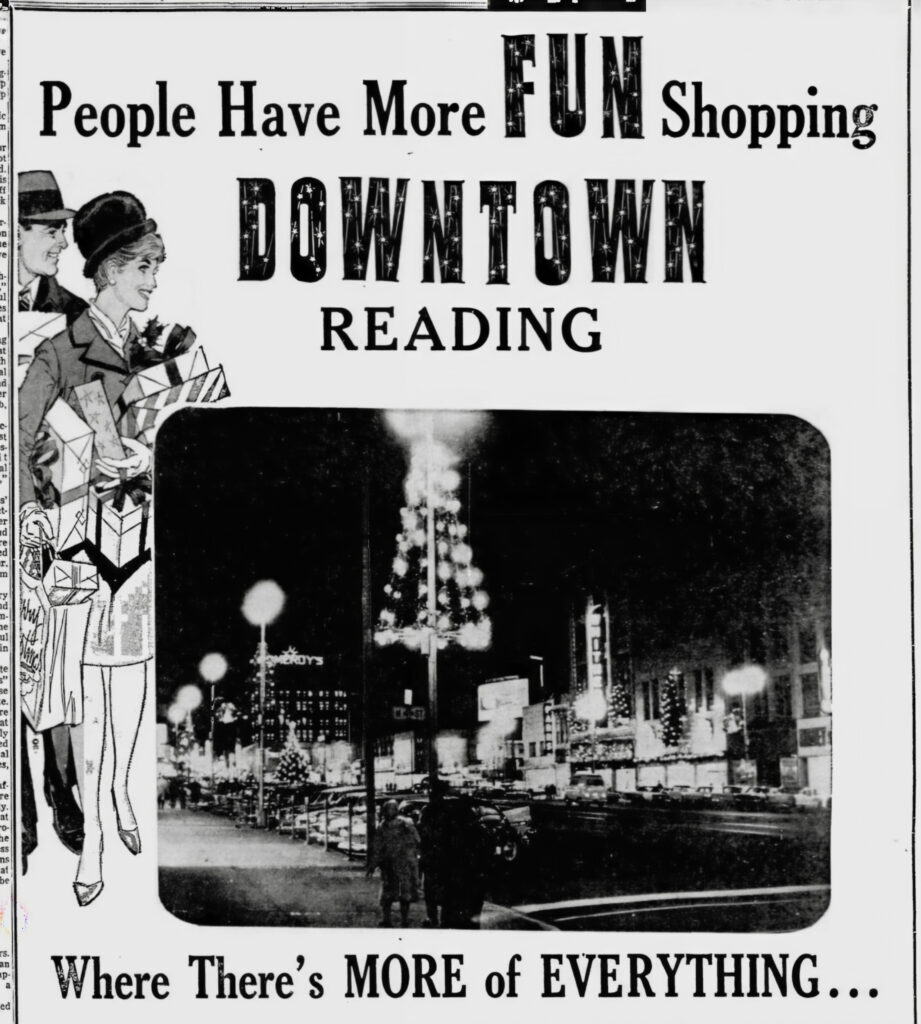
It is no secret that the Berkshire Mall, which opened in 1970, decimated downtown shopping. Reading’s Penn Square had been a hub for trade and commerce for the entirety of Berks County’s history, which was well over 200 years in the making at that point. A Model Cities program aimed at urban renewal was implemented to combat this in 1973. Much of the 600, 700, and 800 blocks of Penn Street had been completely razed for revitalization; which included plans for an indoor shopping mall that never materialized. While many seem to have an opinion on the mass destruction of this renewal era, the reality is these structures lining Penn were nearly a century old and in dire need of rehabilitation in a time when renovating old buildings wasn’t considered economical or practical. A November 14th, 1973 Reading Eagle article quoted former Reading Mayor Victor Yarnell as saying that Penn Street is “better off cleared and in fields” than occupied by dilapidated buildings. In addition, these structures provided a surplus of retail space in a time when retail was increasingly moving toward the new malls. Very few businesses were interested in investing in a city shopping district by this time. The city was faced with the choice of letting the structures continue to sit vacant in disrepair or attempting to create new investment opportunity in a place not many wanted to invest. A rock and a hard place, if you will.
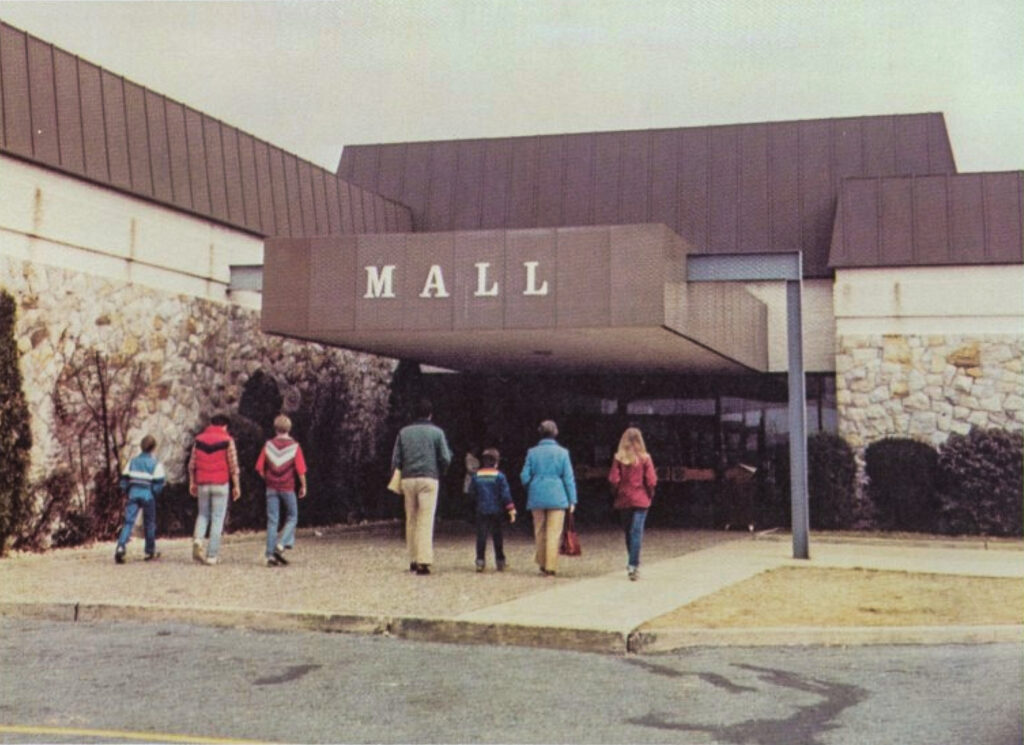
In 1977 the city spent $1.1 million developing an outdoor pedestrian mall which closed off Penn between 5th and 6th streets to vehicle traffic. Reading’s once behemoth retail names, such as Pomeroy’s and Whitner’s, both opened Berkshire Mall locations in addition to their downtown spaces. Ultimately even they couldn’t be saved from our transition to mass consumerism and both folded in the 1980s. By 1984 businesses were complaining that cutting off traffic had hurt and their business and by 1990 it was clear this attempt to drive foot traffic downtown did not slow the decline. The pedestrian mall was removed completely in 1993.
In retrospect nothing was going to stop the downfall of downtown shopping. Everything the city did in this era was effectively sticking fingers in the holes of a leaking dam. Society moved on, Malls were “in” and money was being poured into developing suburban areas while growth in cities stagnated.
Deindustrialization and a rise in Service Industry
The 1970s were also a pivotal time for the deindustrialization of our country. Nationally employment in manufacturing declined from about 28% of the workforce in 1970 to about 18% in 1994. Today, manufacturing jobs account for roughly 10.8% of the United States economy. While I can’t find specific statistics, it wouldn’t surprise me if Reading’s manufacturing labor percentage in the first half of the 20th century far exceeded the national average.
NAFTA being implemented in 1994 hastened the fall of American manufacturing. The globalization of the economy has allowed American companies to seek cheaper labor elsewhere at the expense of the American worker. Hardly shocking that a city built on industrial manufacturing tanked when it up and left.
In the 1980s and 90s Penn Square in Reading was briefly replaced by “white collar” service industries – banking and insurance namely (CNA, Meridian Bank, etc.) – occupied most of the large spaces and employed many of Berks County’s young professional class. The vast majority were commuting in from the suburbs. Inherently there are even more economic challenges when people living outside of a community are the driving workforce there. Regardless, those businesses eventually folded or left as well. The CNA building was redeveloped to the tune of $20 million into Alvernia’s Collegetowne in 2021. The Santander office building on the northeast corner of 6th and Penn is currently in the works to become apartments. With decreasing corporate or commercial opportunity, it seems the only way forward for these structures is to turn them into housing – which leads me to my conclusion…
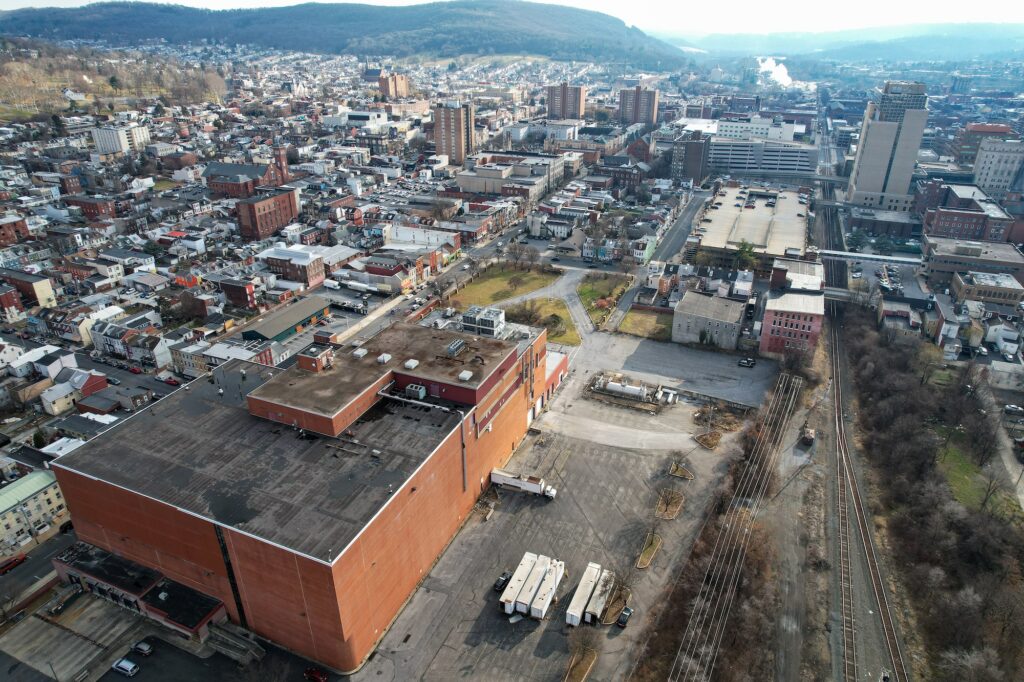
Conclusions
Currently, Berks County and the country at large finds itself in a housing crisis in which affordable living is increasingly hard to come by. Perhaps it is time we look back to our cities and invest in creating affordable housing there instead of developing every square inch of ground in suburban and rural areas. We must also acknowledge that the future of work, which is increasingly remote, makes the need to live near your employer unnecessary. Maybe affordability and flexibility are what drives the middle class back into an urban environment.
To those of you who cite the fact that all cities are democrat-run as being some big “gotcha” proof that Democrat policies can be blamed for the downfall of American cities, I will say this: actively rooting for or relishing in the failure of our cities to reinforce a political view is unAmerican at best. Besides, it ignores the fact that not all cities are suffering as badly as Reading has. We need not look further than our neighbors in Lancaster to see how a city (in which the Mayor and Council are all Democrats) can regain its footing and thrive again. Perhaps our actual problem isn’t party but true leadership, vision and the ability to work together sans ego.
Yet perhaps my biggest question is with those who wish to return to some “golden-era” American society; which part exactly would you like to get back to? Unregulated capitalism at the expense of the majority of society? High taxation and socialist policies which benefitted the majority of society? When things were “safer” under the mob’s total corruption of city government? When industries abandoned American labor in favor of widening their margins? During which part were things really that great?
We can continue to point our fingers at immigrants, and the social and cultural differences that come with them or we can acknowledge the reality of Reading’s problem; the downfall of American manufacturing left a gaping hole where opportunity once was for the working class.
Stop yearning for the days of old. Manufacturing is never returning to what it was a century ago so long as profits are the main priority. The malls are dead and we are firmly in the digital era. We are again on the cusp of a revolution in the way our society functions, as the introduction of Artificial Intelligence will likely shake up our economic make up in the coming decade. Maybe this isn’t the time to be emulating the past. Maybe we need forward thinking people to step up in a big way to navigate us into a brighter future.

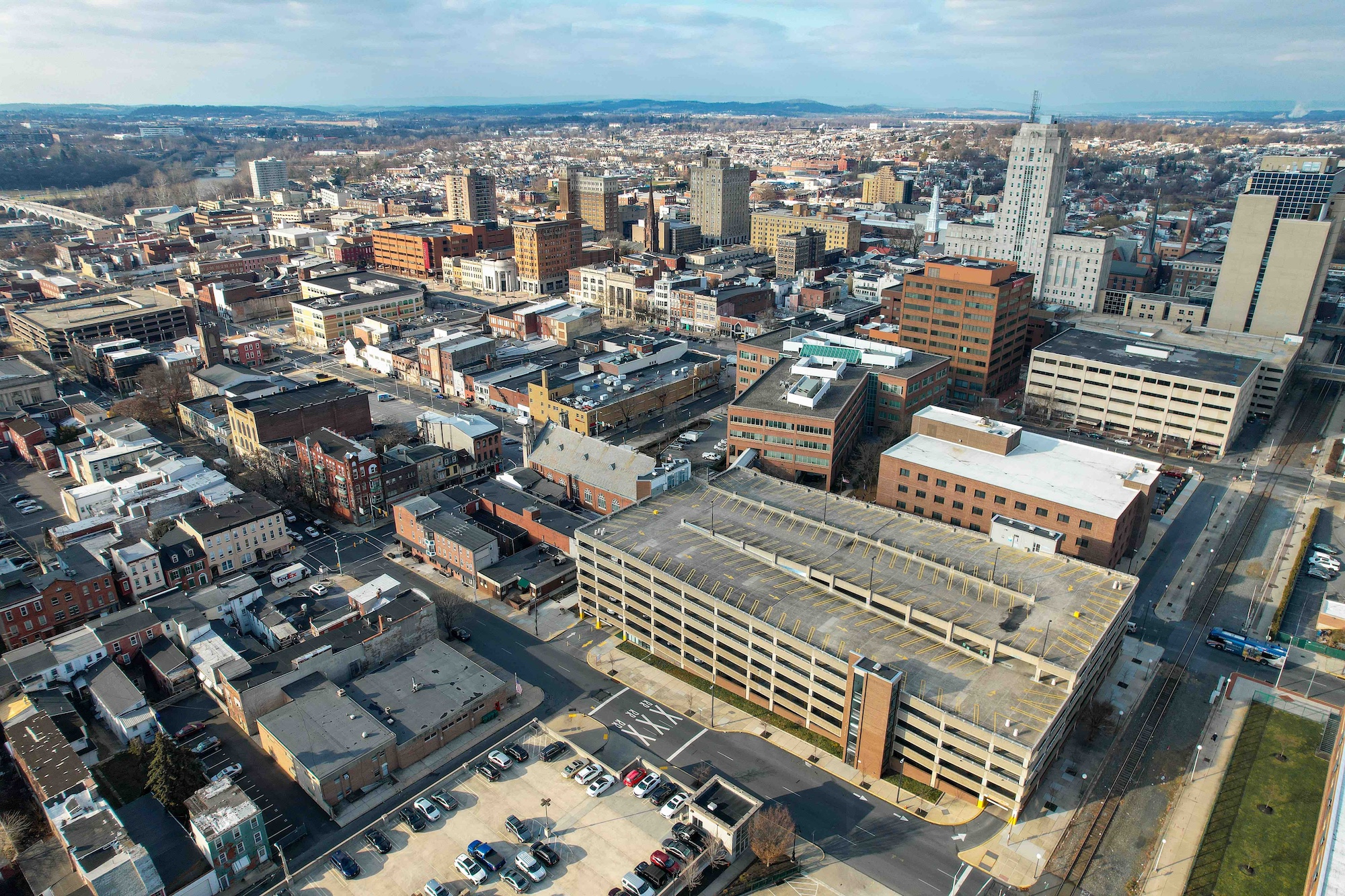
Excellent journalism and explanation of how Reading changed. I grew up in Laureldale graduating from Muhlenberg High School in 1955 and Albright college in 1959. I now live in Corpus Christi, Tx. But, my heart will always be in Reading.
Excellent article, always love your work!
Thank you for the time and effort you put into this article. It is very informative and greatly appreciated.
Well done!
I love this city and root for it’s economic recovery.
I grew up on the southside and have fond memories of my time in reading.
I look forward to my visits with family and friends, most of whom now live on the outskirts of the city.
I agree that what might be needed is a forward thinking, out of the box leadership is need for the future of the city.
There are several examples of downtown city revitalization that Reading could follow. One being the city of Pasadena, CA. There was a time when Pasadena’s business district was not a place you wanted to be in after dark. The city leaders decided to attract numerous business back to the business district by providing tax breaks. Attracting entertainment venues, restaurants, high end stores, etc., to the business district. The goal was to make it a destination point for entertainment, shopping, and dining. Reading has the potential to do the same.
Leadership with a vision is the key.
Another excellent article, maybe your best ever!
Excellent article! I especially like the way you counter general popular opinions with facts. Reading will never be what it once was, a working class town supported by good paying steel mill jobs, but I think if we identify emerging opportunities and work united, we can revitalize the area. I realize it’s easy to say but hard to do. Thanks again, Alexa. Great insight.
As a relatively new citizen of Reading PA, your history was an excellent summary of what one sees in the area of Reading’s past. Certainly the community is in a transition to something different from what was. One could hope that the decline and recent green shoots of rebirth we see in Detroit, or the gentrification of depressed former industrial areas in New York, Brooklyn and the South might help to restore the vitality that was once the best days of Reading. Keep up the good work.
That is an excellent summary of what has happened over the years, I lived outside of Reading from the early 80’s until approximately 2010 and in that time I saw many changes, and not for the good. Your article hit on so many great points. Keep up the good writing and hope for the future of the city.
Great article. I too get tired of all the “everything was so much better in the 50’s & 60’s” comments, they weren’t!
An amazing article. Simple facts that shoot down racist comments.
Excellent article. One nit to pick: The railroad’s name was the Philadelphia and Reading, not the Pennsylvania and Reading. And a minor point about the 1870 and 1920 comparison photos under the section entitled The Gilded Age: If they both were taken from the SE corner of sixth and Penn facing West, then the1870 photo shows the South side of Penn, while the 1920 photo shows the North side. I found an old news article that locates the Schmucker House at Sixth and Penn, but doesn’t mention which corner, so it’s hard to know either the vantage point or the camera direction from the 1870 picture.
I would so appreciate if you would mark the direction of the photos you post…..Looking south, looking northwest….whatever. Moved away from Reading a long time ago. I don’t have my bearings anymore. Thank you. I enjoy your articles and photos.
Thank you so much for the work you put into this. I have learned so much. I appreciate your insight. I am always willing to open my eyes to other points of view of the reasons for why Reading is what it is, today. You have helped shed more light into this problem. There is so much more to learn. Thank you.
“Maybe we need forward thinking people to step up in a big way to navigate us into a brighter future.” Where are you going to get this talent? Far better to return to unbridled capitalism because government intervention hasn’t accomplished anything noteworthy. A case in point is (was) Hong Kong. The only natural resources there is it’s people but because of capitalism, the talents and imagination of those people resulted in a high standard of living that would have never been achieved under central planning.
This is a great article and it’s a topic that everyone that’s ever lived in Reading has probably talked about at some point. What happened? I grew up in Reading/Shillington in the ’70s and ’80s, so my view was of a city that, while not the greatest, at least felt safe. There came a point in the ’90s/2000’s to where it became a scary place. But to just say this happened in the late ’90s would be to overlook all of the history of the City and how it’s fall from grace began many years before. The movement of factories to overseas, along with poor and corrupt governance, led to a slow spiral downward.
But no one can take away the rich history and spirit that made this a once great city. There are plenty of good people still in the area (you, included, Alexa!) that have a similar spirit as the leaders of yesterday. The city can come back. It has a solid foundation. It’s rough and beaten now, but it doesn’t need to be discarded.
I kind of have this fantastical notion that if I could afford to buy every house in the city, I would refurbish and modernize them all while still keeping the original look of the buildings. (maybe also somehow make more parking ,too! lol) I’ve bought my Mega Millions ticket! I’m trying! 😀
I appreciate the kind words, John. I too daydream about having endless funds where I could rehab all of the beautiful buildings. 😅
I’m here because of the Backrooms video series on Youtube by Kane Pixels in his latest video https://www.youtube.com/watch?v=DSWUEmJDglw
Loved this! Well done!
Great article ! You are a wonderful addition to Facebook
Excellent article! Insightful and thought provoking.